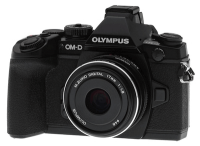Olympus E-M1 review: The mightiest Micro Four Thirds camera so far delivers stunning stills and top-of-class performance
posted Monday, November 4, 2013 at 2:58 PM EDT

Many pros flocked to the Olympus OM-D E-M5 as a lighter, more compact alternative to their big, bulky DSLRs. It was decidedly different from the Micro Four Thirds models that came before it, featuring blazing speed, a 5-axis in-camera stabilization system and best-in-class image quality. The Olympus E-M1 may not be a revolutionary upgrade to the E-M5, but it definitely takes the best of that camera's considerable qualities and reforges them to create a truly pro-level shooting machine with a more ergonomic design, a solid, weatherproof build and better image quality.
The differences between the E-M1 and the E-M5 are readily apparent, starting with the immense number of physical controls -- most of them customizable -- on the new flagship model. There are now dedicated buttons for one-touch white balance, drive/HDR mode, and a 2x2 Dial Control system that lets you change how you shoot literally at the flick of the switch. The larger 2.36M-dot electronic viewfinder ranks among the best we've ever used, and it even allows you to preview Color Control and HDR effects before you snap the shot.
The Olympus E-M1 delivers the sharpest, most detailed JPEGs we've seen from a Micro Four Thirds camera -- if just by a hair over the E-M5 and E-P5 -- with image quality that rivals that of most high-end APS-C DSLRs and CSCs. And despite its comparatively small chip size and 16-megapixel resolution, the E-M1 does especially well in low-light situations at high ISOs, with its JPEG processing outshining that of the top enthusiast, high-megapixel, crop-sensor models from Nikon and Canon. Add the excellent new M.Zuiko Pro 12-40mm f/2.8 lens -- though it's not a kit lens, it can often be bought bundled with the camera for a discount -- and you have one very impressive still image camera.
That said, the E-M1 is not without its flaws. Its menu system and customization options can be overwhelming to learn -- there's just so much you can tweak. Its lack of an optical low-pass (anti-aliasing) filter increases the risk of incurring moiré (though not much more than we found on the E-M5 which has a rather weak OLPF). Meanwhile, other MFT and mirrorless models are much smaller and lighter, meaning the E-M1 loses some of the advantages that the mirrorless design has over DSLRs. And when it comes to the camera's HD video capabilities, unfortunately Olympus has not spent much effort in upgrading them, apparently content for the E-M1 to be a limited, average moviemaker.
In the end, the question isn't if the Olympus E-M1 is an excellent camera. It most certainly is, ranking as one of the best we've tested this year. The question is: Who should fork over the considerable amount of money it costs to buy one?
Read our in-depth Olympus E-M1 review to find out! You'll find a detailed real-world shooter's report, our full IR Lab test results with performance times, side-by-side image comparisons and print quality analysis, and of course, our final verdict on this remarkable camera.